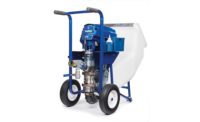How Spray Machines Help with the Labor Shortage
With The Shortage Of Labor Facing This Industry, It Is Important That We Figure Out Ways To Fill That Gap.




If anyone thinks this labor shortage is going away, think again. According to the U.S. Bureau of Labor Statistics (June 2019), unfilled construction jobs are estimated at 300,000, with an anticipated additional need for 747,000 workers by 2026. Not only is the problem here to stay, but it is also going to get worse.
One solution is the ability to complete projects quicker or complete the same projects with fewer people. Equipment can absolutely give contractors the methods to achieve either of these scenarios. Some companies have already mastered the use of equipment, but might not be aware of new technology entering the market.
Specific trades where equipment make a difference:
Painting
Let’s take a look at the contractor who performs painting by traditional brush and roller. Many contractors feel the additional time to mask unpainted areas outweighs the production gains created when using an airless paint sprayer. Painters who have mastered the use of painting equipment know the value of its use. “I estimate we can paint on average three to five times faster over cut and roll,” says Andy Sanchez of Ultra Painting in Albuquerque, N.M. Sanchez, a second-generation contractor, finds he finishes more work with fewer people, he can attest that the equipment is a rational for needing fewer workers.
EIFS
The EIFS trade has many steps in its application. Steps include vapor barrier, adhering foam, rasping foam, embedding mesh, priming, and applying finish coat. All steps have equipment solutions to significantly increase productivity and reduce labor needed to achieve quality.
Listed are the typical EIFS steps with an equipment solution over hand application:
These numbers are based on my estimations from over 20 years of utilizing EIFS equipment in the field. From my experience, when contractors use the equipment above they have the ability to use the same labor to get more work done. This added productivity allows them to grow their business and their profitability.
Self-Leveling Concrete
For the self-leveling underlayment trade the standard of installation utilizes barrel mixers. These 4 or 6 bag mixers are typically wheeled from the mixing area to the placement areas. A 6 bag barrel mixes and places up to 70 bags per hour. Larger projects require using more barrels and more people. The next step involved to increasing production is the use of a pump with a hopper that accepts mixed product poured from barrel mixers. This scenario increases production by eliminating people who wheel the barrels from point A to point B.
There are also machines available that mix and pump the material simultaneously; thus, increasing production by eliminating the need to barrel-mix material in batches. The machines vary in size from 500-pound portable electric units to 10,000-pound trailer units powered by diesel engines. The range of productivity is 100 to 400 bags per hour.
Conclusion
While obtaining equipment is a capital expenditure, the labor savings catch and significantly surpass any money spent on machines. In my 30 years as a subcontractor I was able to justify the expense of equipment purchases by paying for machines in days as opposed to months or years, due to the speed at which I could apply materials.
There is a learning curve with any machine, but understand there are many ways to get more information on new equipment. Equipment and material manufacturers are a great place to start and have experts within their staff who have a vested interest in your success. In addition, many equipment distributors perform demos prior to purchase, or post-purchase training. YouTube is also a great tool to access and look for operational videos from credible sources. Equipment manufacturers populate YouTube with videos on operation and maintenance of their equipment. Finally, trade unions and industry organizations are great sources of knowledge. Many trainers have decades of field experience and are excited to share it.
Many job schedules confine us to smaller areas prohibiting us from using our machines to their full extent. This issue should lead to training the general contractor to have space available for you to be as productive as possible. For those who have mastered their current equipment, perhaps it’s time to delve into larger machines.
My favorite question from a superintendent was, “What can I do to help you make money on this job?” My answer, “Give me an entire floor or elevation instead of just a room or two so I can utilize my equipment!” While this is challenging for them to do on larger projects with multiple trades working in the same proximity, it gets them in the mindset of providing areas for optimal productivity. Their ability to give you larger areas may culminate in weekend of night work. However, the ability to utilize your most productive equipment will overcome any premiums paid for overtime.
Looking for a reprint of this article?
From high-res PDFs to custom plaques, order your copy today!











